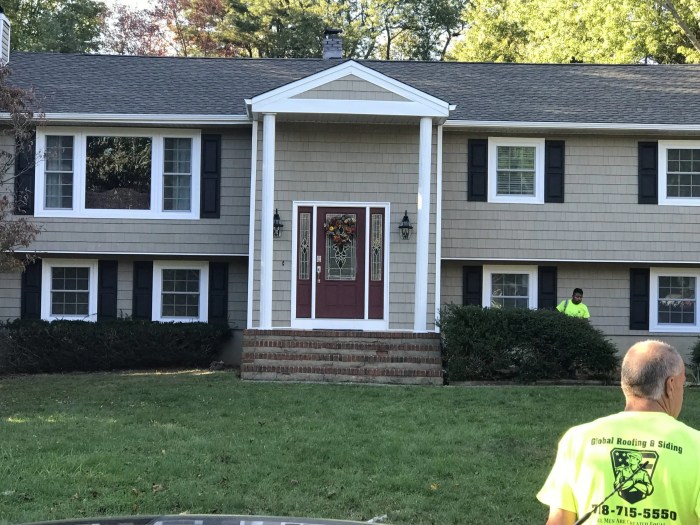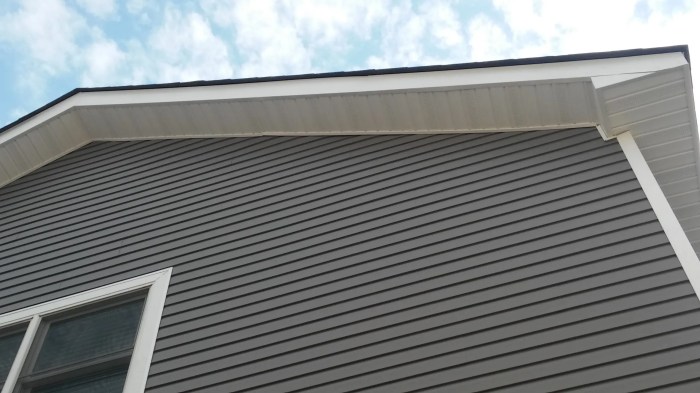Exploring Global Siding and Roofing: A Comprehensive Guide

Delving into the realm of global siding and roofing unveils a rich tapestry of history, innovation, and practicality. From ancient practices to cutting-edge technologies, this topic promises to intrigue and enlighten readers on the world of building exteriors.
As we journey through the nuances of different materials, design trends, and regulatory standards, we uncover the essential elements that shape the landscapes of buildings worldwide.
Overview of Global Siding and Roofing

Global siding and roofing have played a crucial role in the construction industry for many years, providing protection and aesthetic appeal to buildings worldwide.
The quality of siding and roofing is essential in ensuring the durability and structural integrity of buildings. Properly installed siding and roofing can protect a building from harsh weather conditions, water damage, and other external elements.
Types of Materials Used
- Vinyl: Known for its affordability, durability, and low maintenance requirements, vinyl siding is a popular choice for many homeowners.
- Wood: Traditional and timeless, wood siding offers a natural and rustic look to buildings. However, it requires regular maintenance to prevent rot and decay.
- Aluminum: Lightweight and resistant to corrosion, aluminum siding is a practical option for coastal areas or regions with high humidity.
- Asphalt Shingles: One of the most common roofing materials, asphalt shingles are cost-effective and easy to install. They come in a variety of colors and styles to suit different architectural designs.
- Metal Roofing: Durable and long-lasting, metal roofing is known for its energy efficiency and resistance to fire, rot, and pests.
Trends in Global Siding and Roofing
In recent years, the global siding and roofing industry has witnessed several trends that are shaping the way buildings are constructed and designed. From innovative materials to sustainable practices, these trends are influencing the way we think about siding and roofing solutions.
Modern Designs and Materials
One of the current trends in global siding and roofing is the shift towards modern designs and materials. Architects and designers are exploring new textures, colors, and shapes to create visually appealing exteriors. Additionally, materials like fiber cement, metal, and composite siding are gaining popularity due to their durability and versatility.
Sustainability Practices
Sustainability is a key focus in the global siding and roofing industry, with more companies adopting eco-friendly practices. From using recycled materials to implementing energy-efficient solutions, the push towards sustainability is evident in the choice of materials and construction methods.
Green roofs, solar panels, and rainwater harvesting systems are becoming more common in roofing projects.
Impact of Technology
Technology is revolutionizing the way siding and roofing solutions are developed and implemented. Advanced software tools are being used to design and simulate different roofing systems, allowing for more precise and efficient installations. Additionally, the integration of smart technology in roofing systems, such as sensors for monitoring weather conditions and energy usage, is enhancing the overall performance and longevity of buildings.
Comparison of Siding Materials

When it comes to siding materials, there are several options available globally, each with its own set of pros and cons. Let's compare and contrast some of the popular siding materials like vinyl, wood, and fiber cement to help you make an informed decision for your property.
Vinyl Siding
Vinyl siding is a popular choice for its affordability, low maintenance, and wide range of colors and styles. However, it may not be as durable as other materials and can crack or fade over time.
Wood Siding
Wood siding offers a natural and timeless look that many homeowners love. It is durable and can be easily painted or stained to match your desired aesthetic. On the downside, wood siding requires regular maintenance, including staining or painting every few years to prevent rot or decay.
Fiber Cement Siding
Fiber cement siding is known for its durability, fire resistance, and low maintenance requirements. It can mimic the look of wood or stucco without the same maintenance needs. However, fiber cement siding can be more expensive upfront compared to other materials.Overall, the choice of siding material will depend on your budget, aesthetic preferences, and maintenance capabilities
It's essential to weigh the pros and cons of each material carefully before making a decision for your property.
Roofing Systems Across Different Regions

Roofing systems vary greatly across different regions around the world, influenced by factors such as climate, architectural traditions, and material availability. Let's explore the common roofing systems used in various parts of the globe and compare traditional methods with modern technologies.
Roofing Systems in Tropical Regions
In tropical regions with high temperatures and frequent rain, common roofing systems include thatched roofs, palm leaves, and bamboo. These materials are lightweight and provide good ventilation, suitable for the hot and humid climate.
Roofing Systems in Arctic Regions
In Arctic regions with extreme cold and heavy snowfall, metal roofs, often made of steel or aluminum, are popular due to their durability and ability to shed snow easily. Additionally, sloped roofs are common to prevent snow buildup.
Factors Influencing Roofing System Choices
- Climate: The climate of a region plays a significant role in determining the type of roofing system that is most suitable. Extreme temperatures, rainfall, and wind conditions can impact the choice of materials and design.
- Architectural Tradition: Many regions have a long-standing tradition of using specific materials and styles for roofing, influenced by cultural practices and historical construction methods.
- Material Availability: The availability of roofing materials locally can greatly influence the choice of roofing systems. Regions with abundant resources of a particular material are likely to use it for roofing.
Comparison of Traditional vs. Modern Roofing
| Traditional Roofing | Modern Roofing |
|---|---|
| Often made from natural materials like thatch, wood, or clay tiles. | Utilizes advanced materials such as asphalt shingles, metal panels, and synthetic membranes for improved durability and longevity. |
| Relies on craftsmanship and manual labor for installation. | Can be prefabricated for easier and quicker installation, reducing labor costs. |
| May require more frequent maintenance and replacements due to natural wear and tear. | Modern materials are designed to be more resistant to weathering and require less maintenance over time. |
Global Regulations and Standards
When it comes to siding and roofing practices on a global scale, there are specific international regulations and standards that govern these processes. Compliance with these regulations is crucial to ensure the safety, durability, and quality of construction projects.
International Building Codes
One of the key aspects of global regulations for siding and roofing is the adherence to international building codes. These codes set the standards for construction practices, materials used, and structural integrity to guarantee the safety of buildings and occupants worldwide.
Environmental Impact
Another important factor influencing siding and roofing practices is environmental regulations. These regulations dictate the use of eco-friendly materials, energy-efficient designs, and sustainable practices to minimize the environmental footprint of construction projects. Compliance with these regulations is essential to promote environmental sustainability in the industry.
Last Recap
In conclusion, the intricate dance between aesthetics, functionality, and regulations in the global siding and roofing industry paints a vivid picture of craftsmanship and compliance. As we look towards the future, the evolution of these vital components will continue to influence the way we build and maintain our structures, ensuring durability, sustainability, and architectural beauty for generations to come.
Questions and Answers
What are some common materials used in global siding and roofing?
Common materials include vinyl, wood, fiber cement, metal, and brick.
How do sustainability practices influence the global siding and roofing industry?
Sustainability practices drive the use of eco-friendly materials and energy-efficient designs, promoting environmental consciousness in construction.
What factors determine the choice of roofing systems in different regions?
Climate, architectural styles, building codes, and material availability play crucial roles in selecting roofing systems.
Why is compliance with international regulations important for siding and roofing projects?
Compliance ensures safety, quality, and adherence to global standards, enhancing the overall integrity of construction projects.
How do environmental regulations impact material choices in the siding and roofing industry?
Environmental regulations influence the selection of sustainable, recyclable, and energy-efficient materials to reduce the environmental footprint of buildings.




